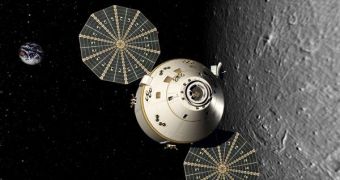Unlike the Apollo missions which took the first man to our natural satellite, the future Crew Exploration Vehicle that will deliver the Lunar Surface Access Module to the surface, after which it will remain on the orbit, will most probably have no humans on board, and will have dual role in the future lunar missions: to deliver and return the lunar lander, and to execute possible rescue missions in case the lunar lander will fall into a wrong permanent orbit around the Moon.
The United States plans to revive its lunar program after more than three decades since the last man walked on the surface of the Moon, and put a man on the Moon by the year 2020. Previously thought to be designed as a delivery and return vehicle for the Altair lunar lander, the Orion will also have the ability of piloting on its own and scan for the signals of the lunar lander in order to determine if it is following a correct trajectory, if not to rescue the lander and reset it for another try.
The CEV Orion will most probably be equipped with a set of two radio antennas, for stereoscopic listening in order to make precise measurements of the position of the lunar lander, in much the same way humans pinpoint the precise direction a specific sound comes from. This system would be used for distances up to three kilometers; however, for accurate measurements it is planned to use a laser system which will take over as the lander fall farther away from Orion.
Sensors mounted on the Altair lander would process information provided by the laser system, in order to make speed adjustments and trajectory. Similar devices have been successfully developed by Defense Advanced Research Projects Agency and tested on the Orbital Express satellite to develop a automatic rendezvous and docking procedure, or to use a human assistant.
The previous automated docking system using radar has been equipped on unmanned vehicles, like the Russian Progress, which is being currently use to transport cargo to the International Space Station. Anyway, the radar system is rather heavy and uses high power resources. The laser currently under development at NASA could also be used to make distance measurements based on image recognition techniques. However, the Orion is not designed to make such readings, and would serve to no purpose except for adding extra weight on the vehicle.

 14 DAY TRIAL //
14 DAY TRIAL //